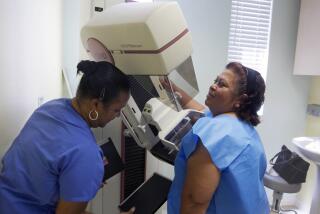Over-35 Pregnancy No Longer Termed ‘Risky’
It is a notion so basic to the prevailing concepts of motherhood that it is accepted as a truism--something women might as well simply accept.
It holds that when a woman turns 35, pregnancy becomes a potentially dangerous proposition. Her ability to conceive and carry her fetus to term are, somehow, compromised overnight, and she becomes a member of a category called “high risk.”
Unprecedented Rate
But now, with births among women 35 and over increasing at an unprecedented rate--indeed, one Westside hospital has discovered the largest age category for women giving birth in its delivery center is 35 to 42--doctors across the country are coming to agree that the old truism should be called something else: bunk.
This modification of opinion has occurred with little fanfare. But today, both the American College of Obstetrics and Gynecology and the federal government’s National Institute of Child Health and Human Development agree that, with minor qualification, a healthy 35-year-old, or older, can look forward to as safe a pregnancy and as healthy an infant as a woman in her early 20s.
A wide variety of factors is believed to be responsible. They range from improved nutrition and the availability of tests like amniocentesis--that can give an early warning of a pregnancy that ought to be terminated--to the contemporary tendency for women to wait longer to begin families and have fewer children than their mothers and grandmothers once they start,
Even the taxonomy of childbirth is being subtly changed. For instance, in medical parlance heretofore, a woman 35 or older who was pregnant was branded “elderly,” nomenclature that is being recognized now as so archaic it was condemned recently in a medical journal as “obsolete and, in fact, offensive.” Such women ought not to be called old, these doctors say, but should, in fact, be recognized simply for what they are: “mature.”
And while some experts say they think this new belief may be based more on biological common sense than proof that has come from carefully designed research, the first such studies have already begun to emerge. They paint a picture of pregnancy among women 35 to 40, and even beyond, far different from what women may have been taught by their mothers and their physicians.
Among the first of these studies is one done at Memorial Hospital Medical Center of Long Beach and published last year with almost no public notice. It found that when 1,023 births among women 35 and older (all but about 1% were 40 or younger) were compared to those of 5,343 women 20 to 25 during a three-year period ending in 1983, the overall safety of the older women’s pregnancies made it clear that such women “may be of no higher risk” than younger mothers.
That is not to say there aren’t differences between pregnancy before and after 35, because there are. But what happens to a woman as she matures is now being seen primarily as a shifting from one set of risks to another. Older women may miscarry more often than younger women, the Long Beach study found, but they are less likely to suffer from maternal fever disorders and significantly more likely to have a baby of normal weight.
Because she is more mature, a woman 35 or older is statistically more likely to have adult-onset diabetes or high blood pressure than a younger woman, and these diseases may require that she be more carefully monitored than a younger woman or may even indicate that pregnancy for her at all would be unwise. But statistically as well, the older woman is less likely to fail to progress normally in delivery, less apt to require anesthesia and less liable to deliver an infant requiring admission to a neonatal intensive care unit.
These findings and refinements of medical opinion are emerging in the midst of one of the most historically significant trends in childbirth. Projections from the federal government’s Centers for Disease Control indicate that, by the end of the decade, childbirth among women 35 and older will have increased by 37% from its level in 1980--to an annual total of 186,000 babies.
Decline in Teen Births
At the same time, births among women 15 to 19--a segment that is worrisome because its members are so young--will go down by 32%, to 407,435.
By the end of the decade, the CDC projections indicate, births among women 40 to 45 will account for slightly more than 1% of all births in the United States, up from .69% in 1980. While the percentage may seen insignificant, the changing demographics of childbirth mean that women 40 to 45 will produce 39,762 babies in 1990.
The percentage of all births that occur in women 45 to 49 will remain unchanged at .05%, but because the number of women in the age category will increase, births in this oldest group will be up to 2,135 in 1990 from 1,693 a decade earlier.
Government experts quickly add that, though it may be tempting to credit improved health-education and birth-control programs for the drop among teen-agers, the real reason is that the Baby Boom generation of women reaching their 40s by 1990 is significantly larger than the generation of girls and women who will be 15 to 19 then. So the expected reduction in teen-age pregnancy may have more to do with the size of young mothers’ age group than anything public-health experts have done deliberately.
As a consequence, CDC experts speculated as early as 1982, by 1990, the demand for prenatal care by teen-agers will decrease, but that relaxation will be tempered by escalating requirements by mothers 35 and older for pre-birth genetic testing.
Demand for amniocentesis and other such tests may grow to as many as 1.1 million patients a year by the end of the decade, the CDC estimated. If all of that increase in demand actually materializes, the CDC concluded, existing laboratory facilities will have to be greatly expanded or they will be strained beyond capacity.
The Long Beach research project was organized by Dr. Donna S. Kirz, then a fellow in obstetrics and gynecology and the medical center’s Women’s Hospital division. The study was begun, Kirz reported in the American Journal of Obstetrics and Gynecology last year, because medicine in general is “somewhat pejorative in its attitude toward women bearing children in their 30s and 40s.
“The older pregnant woman has been variously referred to as being postmature, premenopausal, geriatric, gray, elderly, dangerous and participating in childbearing in the twilight of the reproductive career.”
But when Kirz, researcher Wendy Dorchester and Dr. Roger Freeman, chairman of the hospital’s obstetrics-gynecology department, looked at actual outcomes of the two groups of older and younger mothers, what they found, Freeman said in a telephone interview last week, tended to strike at the heart of what had previously been medical wisdom. The births in question had occurred between Jan. 1, 1981, and Dec. 31, 1983.
The Long Beach results found no differences in stillbirth or neonatal death rates among the older and younger women. The older women showed more evidence of some forms of abnormal fetal positions than the younger women, but the positions were reversed for other types of abnormal presentations. Older women required more Caesarean sections but their labors showed normal progression in a greater percentage of cases than the women 20 to 25. In many of the most important comparison categories, there were simply no differences between the two age groups.
Diabetes and Hypertension
Older women had a higher incidence of diabetes and hypertension but less incidence of premature labor.
In all, the Long Beach team concluded: “When they are given good prenatal and intrapartum care and when the signs of hypertension and diabetes are monitored, the risks to healthy women 35 years and older in the 1980s may be no more than the risks of the younger (women).”
Dr. Preston Dilts, professor and chairman of the obstetrics department at the University of Michigan School of Medicine, said that, while there are differences between younger and older women that must not be ignored by their doctors, the conclusions reached by the Long Beach researchers typify a widespread ferment in medicine. Dilts is identified as a top expert in the field by the American College of Obstetrics and Gynecology.
“I was just laughing, asking myself how many times I have used the term ‘elderly’ or in class talked about women 35 or 40 being elderly. But a lot of things have changed. When we talked about elderly patients in the past, we were talking about people with six, eight, 10, 12 children. That’s a whole different ballgame. That woman’s body is exhausted by repeated pregnancy.
“But those of us seeing older women have begun to realize that these ladies (today) do as well as anybody else does. However, there is still a great perception among doctors that these are high-risk patients.”
Dr. Donald McNellis, special assistant for obstetrics at the National Institute of Child Health and Human Development in Bethesda, Md., agreed that “there is a growing feeling” that women 35 and over should no longer be automatically assigned to a high-risk category. McNellis cautioned, however, that there is not yet enough hard data to fully and finally lay the old belief to rest.
McNellis said he believes what may have occurred is that today’s older mothers, as products of the growing movement among women to be aware of issues created by their own reproductive health, are routinely better off nutritionally and in terms of what they know or are willing to find out about their bodies than their predecessors.
Today’s women are delaying their first conceptions longer than women before them and, while this may mean it takes longer to get pregnant the first time for contemporary older mothers, their reproductive systems are in good condition for pregnancy once they do.
Some doctors note that, at about age 25, a woman may require a statistical average of about four months to become pregnant the first time while a 35-year-old may require a statistical average of seven or eight months of attempts. Doctors caution that the figures are only averages that may not have any direct bearing on the time any individual woman may require.
Open to Controversy
To some extent, though, said McNellis, the reasons for the decrease in risk status among older women remain open to controversy. “I don’t think there is a consensus on this. I think there is a debate going on,” he said in a telephone interview.
Dr. Charles Hamrell, chairman of the obstetrics and gynecology department at Santa Monica Hospital Medical Center, said he agreed with assertions that today’s older mothers in general face about the same degree of pregnancy risk as younger women. Hamrell and other doctors cautioned, however, that older mothers must still exercise caution--particularly in having pre-delivery evaluation by amniocentesis to determine if their fetuses are deformed or genetically damaged.
Hamrell noted that miscarriage rates among older mothers may be higher than those of younger women, but he said that is because maturing reproductive systems produce eggs that are not quite as strong as those of younger women. Miscarriage, he noted, is often part of the natural process of terminating substandard pregnancies.
“For most of these women, once they conceive, the pregnancy is easy,” said Hamrell. “So from that standpoint, if you have a healthy woman over 35 and her body is working well, she is going to do just as well as a younger woman.”
Hamrell noted that a statistical analysis last year by the California Department of Health Services found 5% of pregnancies statewide are now among women over 34. The proportion in Los Angeles County is even higher--6.6% between 1978 and the start of 1982, rising to 7.4% in 1982. Santa Monica Hospital’s statistics underscore the somewhat upscale demographics of delayed childbirth, he said, since the hospital’s figures for birth among women over 34 were 11.5% of all deliveries from 1978 through the beginning of 1982 and 14.4% in 1982. Figures for later years have not been compiled.
Delays in Childbearing
Dr. Joseph Oliver, chairman of the obstetrics and gynecology department at Huntington Memorial Hospital in Pasadena, said the changing demographics or childbirth are related to delays in childbearing imposed by women’s growing tendency to establish themselves in careers before starting their families.
“I think what’s happened over the last 20 years is we have developed techniques so we can assure (older women) that they are going to have a normal baby,” Oliver said, citing amniocentesis and ultrasound screening as examples of the trend.






